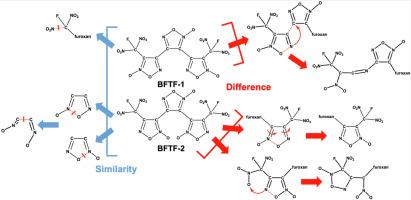Comparative study on the unimolecular decompositions of energetic regioisomers: BFTF-1 and BFTF-2
Abstract
Regioisomeric energetic materials displayed different properties and performances. Understanding the regioisomerism in energetic materials and how it impacts the properties of energetic materials could provide insights into their improvements and designs. The present study explored the electrostatic properties for two regioisomers of energetic material, 3,4-bis(3-fluorodinitromethylfuroxan-4-yl)furoxan (BFTF-1) and 3,4-bis(4-fluorodinitromethylfuroxan-3-yl)furoxan (BFTF-2), which differ in the orientations of N-oxides in the furoxan rings on both sides. The strengths for corresponding covalent bonds in both isomers appeared to be similar, while the intramolecular interactions were distinctively different due to regioisomerism. The proposed decomposition pathways predicted from quantum mechanics (QM) calculations showed that BFTF-1 and BFTF-2 shared similar decompositions of nitro moieties in fluorodinitromethyl groups and furoxan ring openings followed by CC bond breakage. Both isomers also displayed different furoxan ring opening involving neighboring groups due to regioisomerism. The reactive molecular dynamics simulations confirmed that NO2 would be the initial products for both isomers and the species of molecules in their final products are similar. The present study provided insights into understanding the regioisomerism affecting the thermal decompositions of isomeric energetic materials and laid the ground for further improvements and designs.


 求助内容:
求助内容: 应助结果提醒方式:
应助结果提醒方式:


